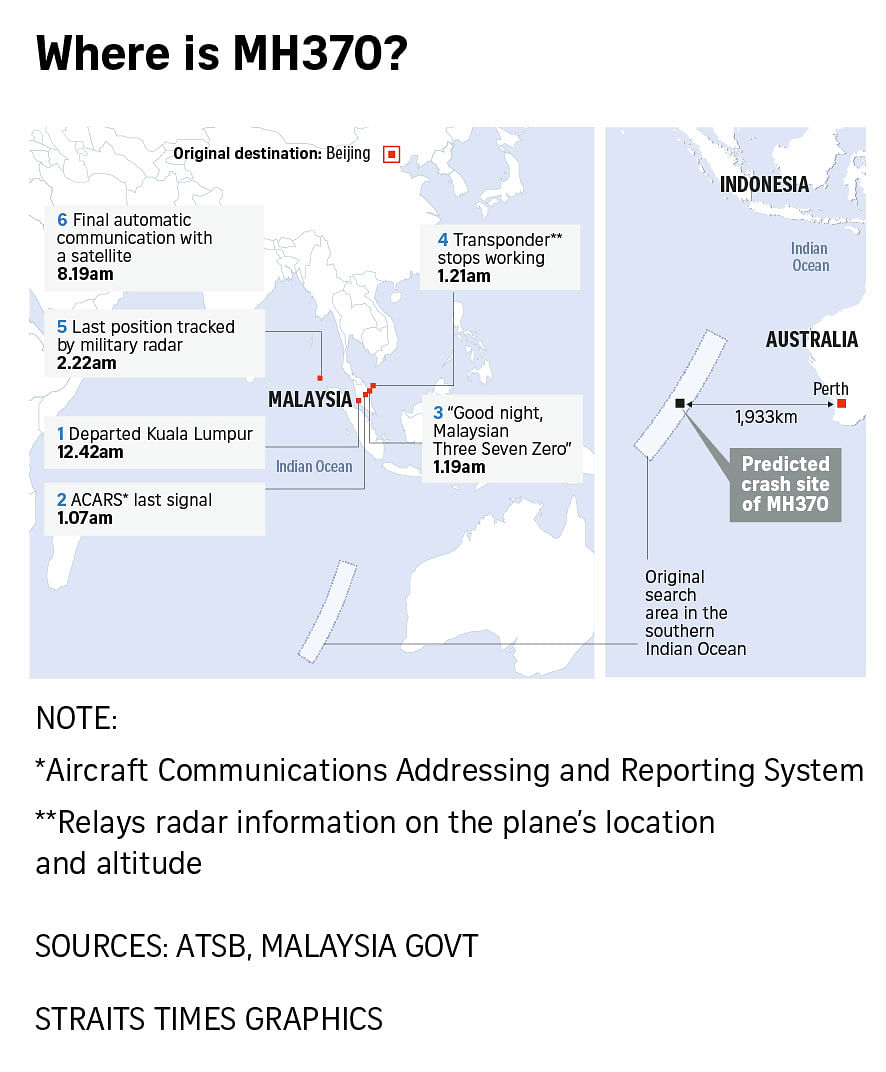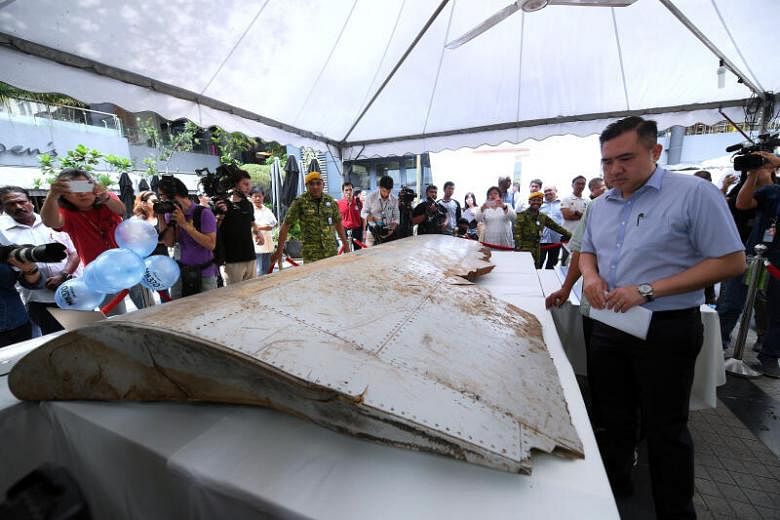KUALA LUMPUR - On this day eight years ago, a passenger plane en route to Beijing from Kuala Lumpur went missing, along with the 239 people on board, never to be seen again.
The disappearance of Malaysia Airlines Flight MH370 in 2014 has become one of the biggest unsolved mysteries in aviation history.
Over the years, scientists, journalists and others have dug deep for answers to how a Boeing 777 could have vanished, and why.
Today, they are no closer to the truth.
But a purported new lead has led to some calls for a new search.
British retiree Richard Godfrey said in December last year that he has calculated the coordinates of MH370's final resting place.
He believes the plane crashed some 2,000km west of Perth, Western Australia, in the Indian Ocean.
Mr Godfrey, a member of the MH370 Independent Group of scientists, researchers and individuals looking into the plane's disappearance, said he used data from the Weak Signal Propagation Reporter (WSPR) to determine the location.
It is a grid of radio signals which covers the globe and records anything disturbing or passing through the waves.
He said MH370 tripped off a series of radio signals before it disappeared.
Combining the WSPR details with other data such as satellite data and debris drift data, Mr Godfrey believes he now has the likely location.
Sharing his findings at a virtual MH370 remembrance event on Sunday, Mr Godfrey said the location is "around 33 degrees south and 95 degrees east in the Indian Ocean".
"We've searched that area before… it's very difficult terrain, very rugged. There are canyons and volcanoes, the ridges and cliffs. So it may have been missed," he said.
In a statement last month, the Australian Transport Safety Bureau (ATSB), while acknowledging that Mr Godfrey is a credible expert, said it had searched a "significant portion" of the area that he highlighted and had not found the wreckage.
But it said it requested that Geoscience Australia review the search data and "revalidate that no items of interest were detected in that area".
The Malaysian authorities said last month that if the new finding proved to be credible, they would consider discussions with China and Australia to launch a new search mission.
During the remembrance event, Transport Minister Wee Ka Siong said in a pre-recorded video: "Please let me reiterate the government of Malaysia's aspiration to locate MH370 has not been abandoned. We just need credible and actionable evidence to act on before we can mount an expedition which we are certain could yield results."
Mr Oliver Plunkett, group chief executive of Ocean Infinity, a private seabed exploration company which had previously searched for the plane on a "no-win, no-fee" basis, said at the event that it was "worthwhile" to conduct another search based on the new findings.
Ocean Infinity has offered to resume the search early next year or in 2024. It is building remotely controlled ships for ocean surveys which will be ready by then, Mr Plunkett said, describing them as "probably the most modern, cutting-edge ships in the entire world".
Mr Peter Foley, who was ATSB's director of operations for the Australia-led search from 2014 to 2017, said the search was ended "prematurely" and that finding MH370 is crucial for the safety of future commercial flights.
"There is no risk for the Malaysian government if they agree (to Ocean Infinity's offer)... We can't afford to fail again. We must find MH370 this time around."
The facts
Flight MH370, bound for Beijing, departed from Kuala Lumpur International Airport at 12.42am on March 8, 2014.
It last made contact with air traffic control at 1.19am over the South China Sea, with the words: "Good Night, Malaysian Three Seven Zero".
Its final known sighting on military radar was at 2.22am.
There was no distress call from the cockpit or from passengers on their mobile phones.
Of the 239 people on board, 153 were China nationals; 38 were Malaysian and the rest from Indonesia, Australia, India, France, the United States, Iran, Ukraine, Canada, New Zealand, the Netherlands, Russia, and Taiwan.
There were two pilots, 10 flight attendants and five children.
The search for MH370 was one of the largest surface and underwater hunts in aviation history. An Australian-led underwater search covered 120,000 sq km at an estimated cost of about A$200 million (S$202 million) before it was suspended almost three years later.
Malaysia and countries such as Indonesia, the Philippines, Singapore, Vietnam, India, China, France and the United States took part in the operations.
Areas near Vietnam in the South China Sea and near Penang in the Strait of Malacca were combed in the initial days after the incident, until a week later, on March 15, when Malaysia's then Prime Minister Najib Razak revealed that data showed the flight had changed course and headed towards the Indian Ocean.
MH370's transponder - a transmitter in the cockpit that allows the aircraft to be tracked by ground radar - was disabled at some point, he said.
Based on data from British commercial satellite firm Inmarsat and Britain's Air Accidents Investigation Branch, the plane is presumed to have crashed somewhere in the southern Indian Ocean.
For nearly three years, underwater search efforts were conducted some 2,500km south-west of Perth. The search in the choppy waters of the vast Indian Ocean was called off in January 2017.
The search was resumed in January 2018 by Ocean Infinity in the southern Indian Ocean, but ended in June the same year without success.
Audio clips from the cockpit failed to shed any light. The pilot's final recorded words to the control tower seemed almost prescient. Yet they were perfectly routine, said aviation experts.
The plane's black boxes - the cockpit voice recorder and flight data recorder that contain information critical for investigations - were never found.
Dozens of pieces of debris from the aircraft have since washed ashore, most of them appearing to support the theory that it went down in the southern Indian Ocean.
The debris include a flaperon - a section from a plane's right wing that helps to control speed and position - which was found on the French Island of Reunion, and a panel from the right part of the tail with the words "No Step", found in Mozambique.
When releasing Malaysia's report on MH370 in July 2018, lead investigator Kok Soo Chon said the safety investigation team ruled out the possibility that the pilot, Captain Zaharie Ahmad Shah, caused the plane's disappearance.
They said controls on the aircraft were likely deliberately manipulated but they could not say who was responsible.
The report's conclusion stated: "The team is unable to determine the real cause for the disappearance of MH370."
The theories
Over the years, theories that have surfaced on what might have happened to MH370 range from the plausible to the ludicrous.
They include a hijacking attempt, a suicide bid, a system malfunction and even alien abduction.
Some theories link the disappearance to Diego Garcia, a militarised island in the Indian Ocean that is British territory and home to a major American naval base.
Others claim a lethal combination of the plane's large cargo shipments of mangosteens and lithium ion batteries might have caused an explosion.
Another theory is that a catastrophic malfunction of the oxygen supply might have knocked out everyone on board and so there was no distress call.
Even in the Sept 11, 2001, attacks in the US, passengers made phone calls when they realised that the aircraft had been hijacked.
A pilot told The Straits Times on condition of anonymity that the oxygen malfunction theory might explain why the flight changed its course and headed in the general direction of Penang instead.
Its pilot could have tried to make an emergency landing at Penang Airport, the nearest main airport that was still open at that time, but failed to make it.
The plane could then have continued on towards the Indian Ocean with everyone on board incapacitated, until it ran out of fuel, he said.
French journalist Florence De Changy posits in her book, The Disappearing Act: The Impossible Case Of MH370, that the aircraft was shot down from above the South China Sea, its remains cleaned up, and the truth covered up by the intelligence authorities.
Ms De Changy, a Hong Kong-based foreign correspondent for French newspaper Le Monde, said that Flight MH370 was carrying a shipment of electronic warfare equipment and was shot down in a botched operation to retrieve the cargo.

The information gap
ST's Malaysia bureau chief Shannon Teoh points to the information gap that has dogged investigations into MH370's disappearance from the start, describing the government's response as "haphazard".
"This was the most difficult situation in crisis communications that I have ever faced. No one really had any idea of who we were supposed to speak to, or how to get more information," he said.
"There were so few facts to go on that you had to consider every and any kind of theory no matter how implausible… It's been so many years, but we still don't know what's right or what's wrong about MH370."
Indian management consultant K.S. Narendran lost his wife Chandrika Sharma who was on board MH370.
"The key questions of what happened, why it happened, how it happened, where it happened… All these questions continue to bog us down," Mr Narendran, who is based in Chennai, India, told ST.
He found some catharsis writing about his personal ordeal in his book, Life After MH370: Journeying Through A Void, published in 2017.
"Eight years have been a long time, and we're no better off today. We're not better informed... I think I've come to make my peace with the fact that I don't know. I may never know."
It is not uncommon for alternative theories to proliferate as people find ways to cope in the aftermath of a sudden disaster.
"Theories and rumours about MH370 persist because of the magnitude of what happened," said Malaysia-based clinical psychologist Joel Low.
"People who had family members or friends on board… are interested in the theories because they give them some hope, no matter how small… Even at this point, just knowing what happened to the passengers would be really great already."
Lawyer Grace Nathan, whose mother Anne Daisy was on board MH370, said at the annual remembrance: "We continue to carry this burden that maybe we will never know... What is more important than our grief, our loss, and our need for closure is the fact that finding MH370 will answer many questions that are of great importance to the international flying community."
She added: "As long as the questions surrounding MH370 remain unanswered, there will always be the risk that something like this can happen again."


